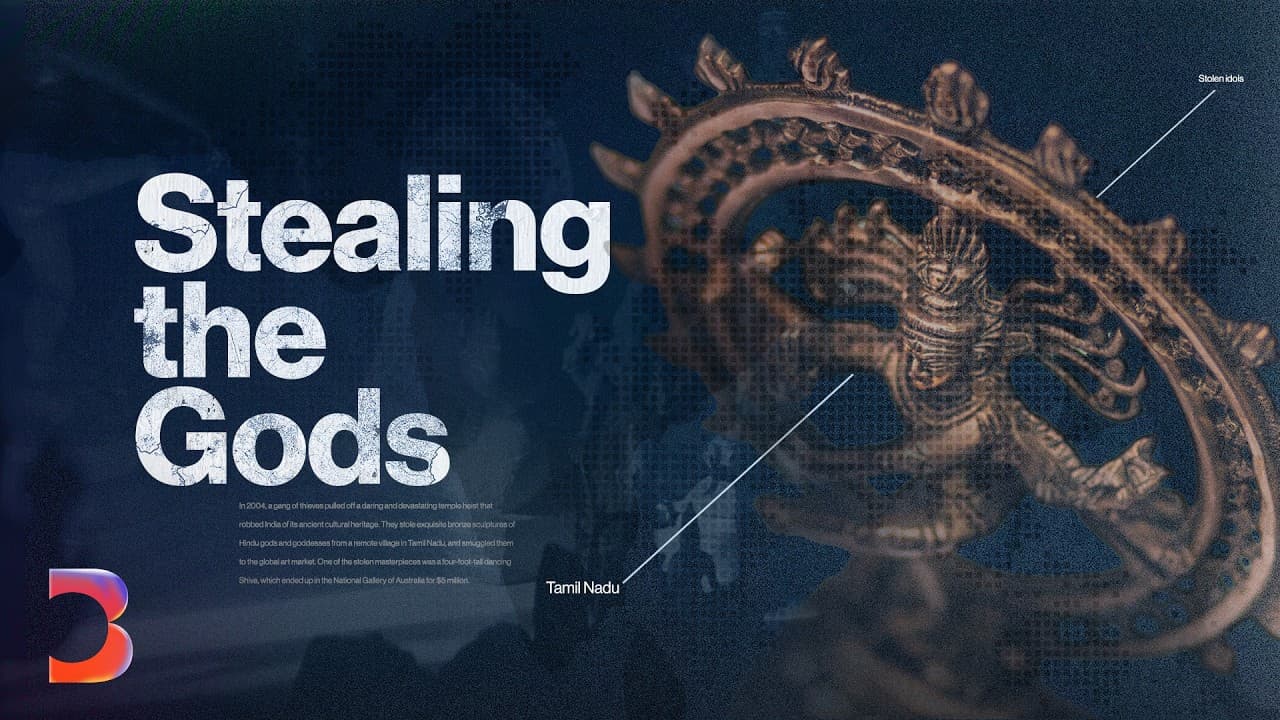Bringing Down India’s Biggest Art Thief | Bloomberg Investigates
24 Jul 2024 (over 1 year ago)

The Theft of Ancient Indian Idols
- In the early 2000s, thieves targeted a dilapidated temple in southern India, stealing bronze idols that were considered sacred and priceless.
- The theft was part of an organized looting operation on an industrial scale, with stolen idols ending up in museums, art galleries, and private collections worldwide.
The Mastermind: Subhash Kapoor
- The mastermind behind the operation became one of the most prolific commodities smugglers in US law enforcement history.
- Subhash Kapoor, a prominent art dealer with a gallery in New York, was known for selling Indian antiquities to museums and private collectors.
- Kapoor's business started legitimately, but he gradually escalated his activities, eventually becoming a major player in the illicit antiquities market.
- Kapoor's success was attributed to his expertise in art, his ability to convince buyers of the idols' high value, and his marketing efforts through catalogs and exhibitions.
- In 2007, US Customs seized a container filled with stolen idols destined for Nimbus Exports, a company owned by Subhash Kapoor.
- Kapoor's hard drive contained evidence of his dealings with traffickers across Asia, including Cambodia, Afghanistan, Southeast Asia, and India.
- HSI seized over 2,500 idols from Kapoor's storage facilities, making it the largest commodity trafficking case in the agency's history.
- Subhash Kapoor, an art dealer, was arrested in 2011 after an investigation by Homeland Security Investigations (HSI) called Operation Hidden Idol.
- Kapoor was convicted in India and sentenced to prison. He is currently fighting extradition to the United States.
- Kapoor maintains his innocence and claims he was framed.
The Victims: Temples and Communities
- The idols, often made of bronze and depicting deities like Shiva, are highly valuable and represent a significant part of the local community's faith.
- Thieves target remote temples with minimal security, exploiting the lack of awareness about the idols' market value among the local population.
The Investigation and Recovery Efforts
- Vijay Kumar, a former shipping executive, dedicated himself to hunting down stolen antiquities, using his knowledge of the shipping industry and his passion for Indian art.
- Vijay Kumar and another individual, who wrote a blog called "Chasing Aphrodite," used the internet to connect with others interested in the illicit antiquities trade and share information about stolen artifacts.
- They discovered that their investigations were uncovering different ends of the same criminal network.
- Vijay Kumar and his network have identified numerous stolen artifacts in museums and private collections around the world.
- They believe that many museums unknowingly possess stolen artifacts, as the thieves often provide forged provenance documents to legitimize their acquisitions.
- Vijay Kumar and his network are working to return stolen artifacts to India, highlighting the importance of protecting cultural heritage and raising awareness about the ongoing theft of antiquities.
- The National Gallery of Australia acquired a Dancing Shiva statue for $5 million, with Subhash Kapoor providing documents claiming it was from the private collection of Raj Mehgoub.
- Investigation revealed that Raj Mehgoub was likely a fabricated figure used by Kapoor to create false provenance for the statue.
- A comparison of the Dancing Shiva with its original form in the temple confirmed that it was indeed stolen.
- Another Dancing Shiva statue, with an inscription in Tamil, was discovered in Kapoor's gallery, leading to the identification of the Suthamalli temple as its origin.
- Police investigations, starting with petty thieves, led to the identification of Sanjeevi Aosokan as a key figure in the theft, acting on Kapoor's instructions.
- Kapoor's arrest in Germany in 2011 was facilitated by information provided by his ex-girlfriend.
- The US Immigration and Customs Department seized over 300 looted antiquities from Kapoor, including objects from the Harappan culture.
The Impact and Importance of Awareness
- The true extent of the loot taken from India is still unknown, with officials estimating that India loses around 1,000 major works of art every year.
- The text describes the theft of ancient Indian idols from temples in India, specifically focusing on the case of Subhash Kapoor, an art dealer accused of trafficking in looted antiquities.
- The text highlights the challenges faced by authorities in combating the trafficking of looted antiquities, emphasizing the need for international cooperation and vigilance.
- The case highlights the ongoing issue of antiquities trafficking, with Manhattan being a hub for the black market.
- The speaker emphasizes the importance of asking the question "Is it legal?" when purchasing antiquities.